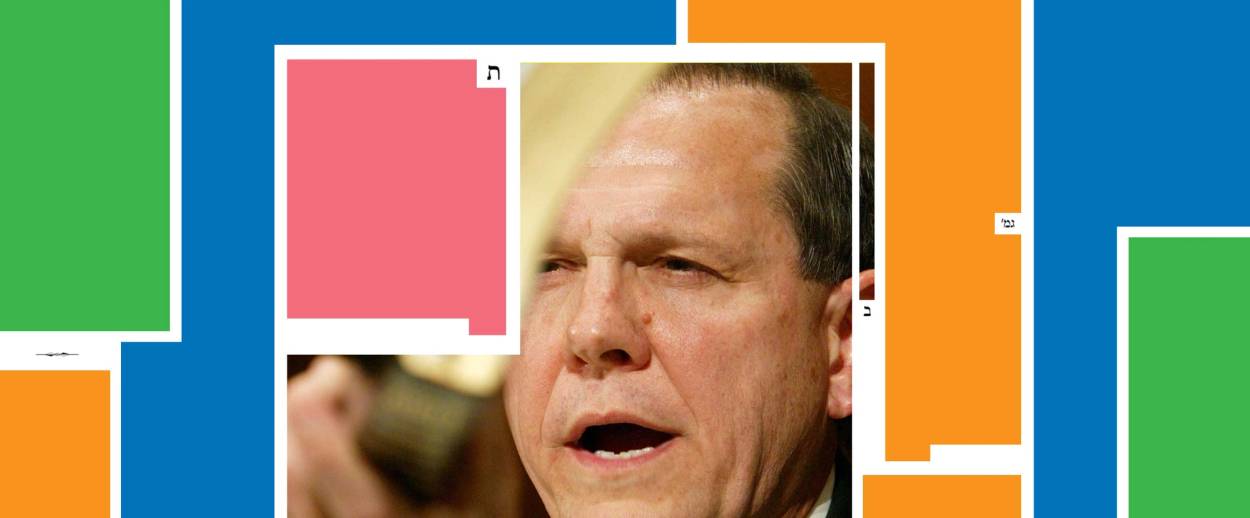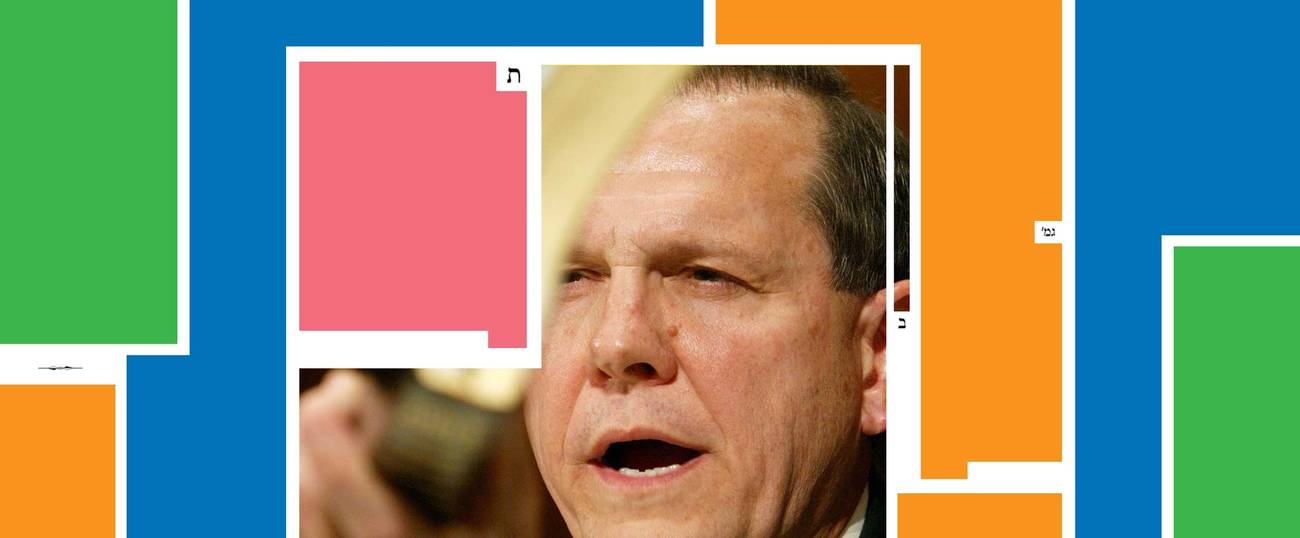Rebellious Elders
Daf Yomi: Why heresy is rare in Talmudic law, where judicial dissent and tiered courts institutionalized freedom of thought




Literary critic Adam Kirsch is reading a page of Talmud a day, along with Jews around the world.
In Chapter Eight of Tractate Sanhedrin, we saw how the rabbis dealt with the case of a “stubborn and rebellious son,” ben sorer u’moreh. Such a wayward youth is condemned to stoning by Torah law, yet the rabbis interpreted the law so strictly as to render its application virtually impossible. This week, in Chapter 10, the rabbis dealt with the complementary case of a “rebellious elder,” zaken mamre; but in this case, it was interesting to see, they make no such effort at extenuation. It seems as if the rabbis are harsher on rebellion when it comes from an elderly and respected member of the community than when it comes from a gluttonous and drunken youth. But why should this be so? After all, the punishment for the elder is strangling, which is considered a lesser sanction than stoning; this might suggest that his crime is less severe.
The reason, as it emerges in the Mishna in Sanhedrin 86b, has to do with the different definitions of rebellion in the case of a young man and an elderly one. The ben sorer u’moreh is defined by his wildness: He refuses to listen to his parents, devoting himself to physical pleasures like food and drink. (Today, the equivalent might be a teenager who gets into drugs.) But as anyone who has ever raised a teenager, or been one, can attest, this kind of wildness is natural to adolescents. Almost all of us are stubborn and rebellious, to some degree, at this time of life. That is surely one reason why the rabbis interpreted this Torah law away: They knew that it might turn a lot of young people into criminals.
A zaken mamre, on the other hand, is not defined by his appetites or his unruliness. Rather, his transgression has to do with stubborn arrogance in the face of authority—the kind of sin that would be especially tempting to a great Torah scholar, who is used to being treated worshipfully. The Torah basis for the concept of the rebellious elder is found in Deuteronomy 17, which commands the Jewish people to obey designated judges, magistrates, and priests. “Should a man act presumptuously and disregard the priest charged with serving there the Lord your God, or the magistrate, that man shall die,” the law says.
For the rabbis, this served as a basis for the principle that no Torah scholar can set himself up as an independent authority, in defiance of the rabbinical consensus. Of course, consensus does not mean unanimity: As the Talmud shows on every page, the rabbis often disagreed on the correct interpretation of the law. The Mishna takes care to preserve dissenting opinions, and the Gemara spends as much time recording losing arguments as winning ones. This dialogic reasoning is cherished by many of today’s students of the Talmud as a token of pluralism. Judaism doesn’t lay down the law in an authoritarian fashion, we often hear, but invites challenges to its own conclusions.
But this is true only up to a point. In most cases, the Talmud does distinguish between dissenting views, which are ascribed to individual sages by name, and the prevailing view, which is attributed to “the sages”—hakhamim in the Mishna’s Hebrew, or rabbanan in the Gemara’s Aramaic. Dissents are recorded because they come from especially revered figures and because they offer insight into how the law can be analyzed. But the consensus view determines the actual conduct of judges and courts. A rebellious elder is a sage who refuses to acknowledge this principle and insists on issuing rulings in accordance with his private judgment, contrary to established legal principles. When Judge Roy Moore, now the GOP candidate for Senate in Alabama, defied the Supreme Court by displaying the 10 Commandments in his courtroom after being told to remove them, he was acting as a classic zaken mamre.
The Mishna in Sanhedrin 86b explains how the court system operated in Temple times. “There were three courts” in Jerusalem: “One convenes at the entrance to the Temple Mount, and one convenes at the entrance to the Temple courtyard, and one convenes in the Chamber of Hewn Stone.” Their proximity to the center of the Temple was proportional to their authority, with each successive court acting as a higher court of appeal. Interestingly, the Talmud does not imagine a defeated litigant challenging the verdict, as in the American system; rather, it is a judge who finds himself in the minority who instigates the appeal. Appearing before the court, “the elder says: This is what I interpreted and that is what my colleagues interpreted; this is what I taught and that is what my colleagues taught.” The judges would then decide who had interpreted halakha correctly.
A sage who lost in the first court could appeal to the second, and from the second to the third, which was the supreme Jewish court—the Great Sanhedrin, made up 71 judges. A sage who lost in this forum had to return home and enforce the Sanhedrin’s interpretation of the law. It is significant, however, that the sage did not have to publicly agree with the Sanhedrin or even teach its view as the correct one. He could continue to teach that he was right on the law: “If the elder returned to his city and nevertheless he taught in the manner that he was teaching previously, he was exempt from punishment,” the Mishna says. This is a sign of how much the rabbis cherished freedom of thought—within the bounds of Torah Judaism, of course.
But if a dissenting sage tried to actually implement his view of the law, issuing rulings that contradicted the consensus and defied the Sanhedrin, then he became a dangerous figure, a zaken mamre. Remember that the court system described in the Talmud was far-flung, loosely organized, and operated on a volunteer basis; there was no Federal Register to publish the latest authoritative judgments. A sage who made wrong rulings in his community was fracturing the unity of the Jewish people, introducing chaos into the transmission of the law, and setting the stage for future conflict. Above all, he was defying the principle, central to rabbinic Judaism, that the rabbis collectively inherited the authority that had belonged to the priests in Torah and Temple times.
That the rabbis were more concerned with defending rabbinic authority than the authority of the Torah is clear from the Mishna in Sanhedrin 88b, which explains, “there is greater stringency with regard to rabbinic interpretations than with regard to matters of Torah.” Thus, if a sage went around directly contradicting the Torah—for instance, by saying that there was no mitzvah to wear tefillin—he was “exempt” from punishment. This is surprising: Surely such a person was a kind of heretic, undermining the authority of the Torah, and therefore deserved the strongest punishment?
But the rabbis, evidently, were not worried about this kind of bad teaching, because it was so obviously wrong that it could never win anyone’s obedience. A person who contradicted the Torah was ipso facto not a Torah sage, and therefore he could not be a zaken mamre. What concerned them was a sage to who contradicted the traditional interpretation of the Torah. Thus a sage who taught an incorrect law for the construction of tefillin, insisting on five compartments where the tradition called for only four, was liable to death.
What other kinds of legal matters might sages disagree about? The verse from Deuteronomy says, “If there shall be a matter too hard for you in judgment, between blood and blood, between plea and plea, between mark and mark, even matters of controversy within your gates.” The Gemara goes on to interpret each clause of this sentence as a reference to a specific legal domain. Some of these inferences are clear: “Between blood and blood” refers to different types of discharge by women, depending on if they are menstruating, giving birth, or suffering from venereal disease. Each of these types of blood is subject to different purity laws, and the judge must know which he is dealing with if he is to prescribe the correct ritual. Again, “between mark and mark” has to do with the marks of leprosy, which, according to the Torah, can afflict dwellings and clothing in addition to bodies.
Other words, however, are interpreted in the looser fashion the rabbis frequently employ, based on tradition or perhaps intellectual convenience. Thus when the Torah refers to “matters of controversy,” the Gemara separates the phrase into two parts. “Matters,” divrei, is related to the Hebrew word for “speech”; thus it refers to the dedication or consecration of property to God, which takes place by means of a spoken vow. “Controversy” refers to the sota, the woman whose chastity is tested with a potion of bitter waters; this makes sense because her infidelity is a matter of controversy between her and her husband. And, of course, there were criminal and civil cases as well. In this way, the Talmud shows that a Jewish judge has to be a master of extremely diverse kinds of knowledge, from gynecology to marriage counseling to property law. No wonder the yoke of judging weighed so heavily on the sages.
Adam Kirsch embarked on the Daf Yomi cycle of daily Talmud study in August 2012. To catch up on the complete archive, click here.
Adam Kirsch is a poet and literary critic, whose books include The People and the Books: 18 Classics of Jewish Literature.